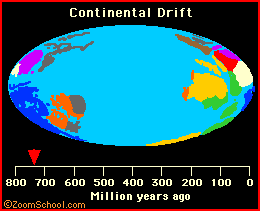New dinosaur species may have left tracks in the snow
Source: CBS News
Spend enough time watching Jurassic Park movies and you start believing all dinosaurs lived out their lives in the tropics, rumbling across rolling plains or grazing in forests.
But a study published on Tuesday found that a new species of duck-billed dinosaur liked it cold and may have trudged through snow.
Examining a site teeming with bones at the Colville River in northern Alaska known as the Prince Creek Formation, researchers from Florida State University and University of Alaska Fairbanks believe this 30-foot-long grazer is the northernmost dinosaur ever found.
"The finding of dinosaurs this far north challenges everything we thought about a dinosaur's physiology," Greg Erickson, a Florida State biological science professor who was part of the team that discovered the new dinosaur, said. "It creates this natural question, how did they survive up here?" . . .
Read more: http://www.cbsnews.com/news/new-dinosaur-species-may-have-left-tracks-in-the-snow/
It makes sense, since we now know that dinosaurs were warm-blooded. I grew up in the '50s ever fascinated by them, and have always remained so. Here's another reason why.

jberryhill
(62,444 posts)Yet another dinosaur going on about how bad they had it.
yellowcanine
(35,699 posts)femmocrat
(28,394 posts)These dinosaurs were believed to have thrived well above what is known as the paleo-Arctic Circle, about 80 degrees north latitude. It may have been cold but not as cold as what visitors might see today. They likely lived in a world where the average temperature was about 43 degrees Fahrenheit, and they probably saw snow. But because temperatures were more temperate than today, the area also was covered with trees.
happyslug
(14,779 posts)Last edited Tue Sep 22, 2015, 08:44 PM - Edit history (2)
And extremely hot in summer. All of this variation in temperatures due to the amount of sunlight. In winter almost zero, in Summer almost all day sunlight. No permanent ice or permafrost but deep snows.
One of the problems with the polar regions is that it is ocean and appears to have been almost always ocean (Unlike Antarctic which is a huge land mass). The rest of the world move about but the Arctic seems to have always existed (More due to how the other continents moved then anything to do with the arctic ocean itself).

http://www.enchantedlearning.com/subjects/dinosaurs/glossary/Contdrift.shtml
In the Jurassic age Europe/Asia and North America were together and both heading to the north:
In the Cretaceous age the Continents broke up and ended up pivoting from each other around the Arctic Circle:
http://www.enchantedlearning.com/subjects/dinosaurs/mesozoic/Jurassic.html
http://www.enchantedlearning.com/subjects/dinosaurs/mesozoic/cretaceous/
Thus by the time of the Dinosaurs the Continents were still south of the Arctic Circle, but close enough to have strong winters with heavy snows.
On the other hand Antarctica was already within the Antarctic circle along with India and Australia. Thus we have long had records of Dinosaurs in that cold environment.

https://en.wikipedia.org/wiki/South_Polar_dinosaurs
Just a comment that Dinosaurs appear able to handle temperatures below freezing for three to six months of a year in the Antarctic and Australia (Both within the Antarctic circle at that time period). These would have been tree covered at that time period.
Now, during the Eocene, the period AFTER the last extinction of the Dinosaurs, temperatures the Arctic region reached tropical levels, palm trees were existing in Alaska and Northern Europe during a time period where both were about the same latitude they are today:
https://en.wikipedia.org/wiki/Eocene#Early_Eocene_and_the_equable_climate_problem
While during the Eocene you had Palm Trees in Alaska, no reports of such occurs during the Cretaceous period, even through that period had an even HIGHER average temperature:
https://en.wikipedia.org/wiki/Polar_forests_of_the_Cretaceous
Why the difference has been a subject to debate for decades. Both were warm periods with NO permanent ice at either pole. Yet you have Palm Trees in Alaska in the slightly colder Eocene but NONE in the warmer overall Cretaceous.
Thus while during the Eocene it is probable that the Arctic was to WARM for Snow, that is NOT true of the Cretaceous. Thus Dinosaurs could have walked in the Snow but only at the norther end of North America and Europe.
The Arctic 94 million years ago:
 ?w=720
?w=720
http://wattsupwiththat.com/2013/09/26/study-the-late-cretaceous-period-was-likely-ice-free/
During the Eocene North America had become a solid piece of land, what is now Central America was still under water as was most of Europe. Thus the best explanation is that during the Eocene the Palm Trees were in Southern Alaska, warmed by waters from the Pacific. Palm trees in Scandinavia was also warmed by currents from the south. In the earlier Cretaceous period what is now England BLOCKED warm currents heading north to Scandinavia and Alaska was under water (with Warm water going NORTH over right is now Alaska but COLD water heading south through what is now the Great Plains, making most of North America very cold in the winter, to cold for Palm Trees during the Cretaceous period.

Just a comment that dinosaurs did live in Snow, best example is in Australia and Antarctica not the Arctic.
https://en.wikipedia.org/wiki/List_of_Australian_and_Antarctic_dinosaurs
Scootaloo
(25,699 posts)Meaning that for half the year it was still plenty cold.
Of course Dinosaurs handled that territory.
Elmer S. E. Dump
(5,751 posts)left-of-center2012
(34,195 posts)I would have thought the accompanying picture would show them in snow?
csziggy
(34,136 posts)But the headline was just a tease. ![]()
![]()
left-of-center2012
(34,195 posts)At least it could have shown them building dinosaur snowmen ! ![]()
csziggy
(34,136 posts)Not posting the photo - but you can see it here:
http://www.phombo.com/travel-culture/fairbanks-ice-festival/7146/full/
yellowcanine
(35,699 posts)Warm blooded and all.